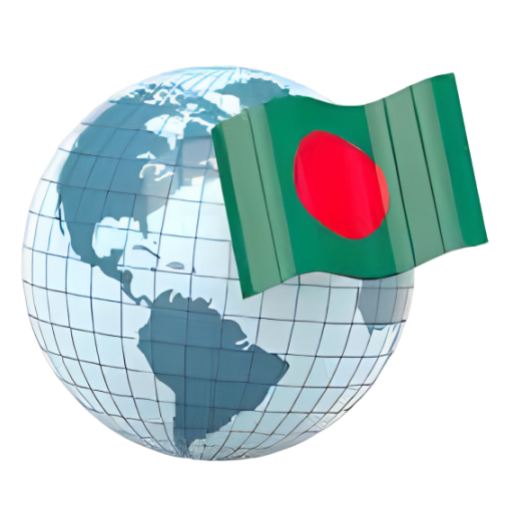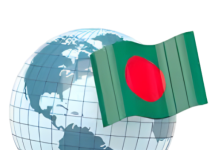
Bangladesh’s liberation could not be achieved only in the nine months liberation struggle had not the country been prepared for many years before the crack down by the Pakistan Army on the night of 25 March 1971, especially by the progressive forces. During the 9 months liberation struggle of Bangladesh, a large part of Shibpur was mostly free from the occupation of the Pakistan Army.
Situated in the Narshingdi district, Shibpur is well known to people of the country and the International Community for its progressive peasant and student movement since the 1960s. Shaheed Asad, whose martyrdom inspired the 1969 student mass upsurge (11-point movement), hailed from Shibpur. A leader of the East Pakista Student Union (EPSU-Menon), Shaheed Asad was an organiser of student and peasant movements in Shibpur.
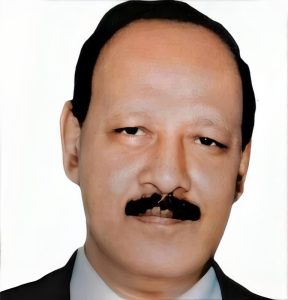 Abdul Mannan Bhuiyan’s name is proudly attached to the Liberation movement and struggle for independence of the people of Shibpur area. During the Liberation struggle the people of Shibpur and a large section of progressive leaders and activists of the country united under the leadership of Abdul Mannan Bhuiyan against the military Junta. Progressive leaders such as Kazi Zafar Ahmad, Mostafa Jamal Hyder, Hyder Akbar Khan Rono, Hyder Anowar Khan Juno, Atiqur Rahman Salu, Kazi Siraj, Shahria Akhter Bulu, Hazera Sultana and many other progressive activists, had closely worked under the leadership of Mannan Bhai. They directly participated in the fight with the Pakistani army and made significant contributions to the liberation of Bangladesh. For details see শিবপুর উপজেলা, বাংলাদেশ মুক্তিযুদ্ধ জ্ঞানকোষ (Encyclopaedia of Bangladesh War of Liberation), বাংলাদেশ এশিয়াটিক সোসাইটি, ঢাকা ২০২০, খণ্ড ৯।
Abdul Mannan Bhuiyan’s name is proudly attached to the Liberation movement and struggle for independence of the people of Shibpur area. During the Liberation struggle the people of Shibpur and a large section of progressive leaders and activists of the country united under the leadership of Abdul Mannan Bhuiyan against the military Junta. Progressive leaders such as Kazi Zafar Ahmad, Mostafa Jamal Hyder, Hyder Akbar Khan Rono, Hyder Anowar Khan Juno, Atiqur Rahman Salu, Kazi Siraj, Shahria Akhter Bulu, Hazera Sultana and many other progressive activists, had closely worked under the leadership of Mannan Bhai. They directly participated in the fight with the Pakistani army and made significant contributions to the liberation of Bangladesh. For details see শিবপুর উপজেলা, বাংলাদেশ মুক্তিযুদ্ধ জ্ঞানকোষ (Encyclopaedia of Bangladesh War of Liberation), বাংলাদেশ এশিয়াটিক সোসাইটি, ঢাকা ২০২০, খণ্ড ৯।
From the Shibpur area, Mannan Khan, Awlad Hossain Khan, Haris Rikabder, Tofazzal Hossain Bhuyia, Sento Mollah, Safder Bhuiya, Jinuk Khan, Abdul Ali Mirdha, Kanchan and others were close lieutenants of Abdul Mannan Bhuiyan. With greater participation of students, youths, peasants and their training inside the country, they organized teams of dedicated freedom fighters who had undertaken many significant operations. A close lieutenant of Mannan Bhai, Maznu Mridha, who defected from the EPR carried out many noteworthy ambush operations. Juno Khan Bhai with Maznu Mridha and 10 other brave freedom fighters carried out ambush operations at Putia, about 7 kilometres from Shibpur. About 30 Pakistani soldiers were killed in that operation, but only two peasants, Idrish and Manik lost their lives. This brave encounter of Putia spread like fire in and outside the country and inspired the freedom fighters.
Abdul Mannan Bhuyian, the then General Secretary of EPSU, and myself. were from the same area – Shibpur, Narsingdi. Shaheed Asad also hailed from the same area. We three together organized progressive movements with students, youths and peasants in our area. During our Dhaka University student life, Mannan Bhai was staying in the SM Hall. I used to visit him quite frequently to discuss political matters.
On 6 November 1969, Maulana Abdul Hamid Khan Bhashani started his movement against the autocratic rule of the Ayub-Monem regime with a public meeting followed by the Lat Bhaban (Governor House) Gherao programme. He declared a hartal (general strike) in Dhaka city from Baitul Mukarram Mosque premises. We took part in a Torch March (মশাল মিছিল) upto Bahadur Shah Park. The hartal was observed spontaneously and in the morning of the hartal one person became a Shaheed (martyr – killed by police bullet near the Nilkhet Crossing. Maulana Bhashani after the very successful hartal in Dhaka, declared Hut Bazar Hartal on 29 November. He wanted to spread the movement to rural areas of the country. To quell the unrest the University authority closed University for an indefinite period.
I went to my village, on the request of Mannan Bhai and joined temporarily as a lecturer in a newly established Monohori College, where most of the teachers were progressive and followers of Mannan Bhai. Mannan Bhai with his colleagues in the College was very busy in organizing Krishak Samity in the area.
Mannan Bhai, Asad Bhai, myself and other activists of Shibpur area were doing groundwork for implementing the hartal called by Bhashani at Hatirdia Bazar, near Shibpur. We chose Hatirdia Bazar to implement the hartal programme as it was a prominent hut in the Shibpur area. On the hartal day 4 peasants were brutally killed by police firing, and Asad Bhai was injured. However, he could come to Dhaka City avoiding arrest. After Hatirdia incident police filled a case, and Asad Bhai was the principal accused in the case. He went into hiding to a remote village.
After the Hatirdia incident, Maulana Bhashani decided to come to Hatirdia and Shibpur to protests the police harassment and hold public meetings at Hatirdia and Shibpur. The authorities imposed “144-section” at Hatirdia and Shibpur so that Maulana Bhashani could not address any public meetings. They also obstructed us when we tried to make a pandal for the meeting and instructed us not to use any mike. Bhashani came from Dhaka in a jeep having a sound system in it. He first had a brief stay over at Shibpur and asked us to ready a chowki (wooden bed), so that it could be used as a pandal. After the Hatirdia meeting Bhashani came to Shibpur, the meeting venue was surrounded by the police. He crossed the police barricade and said, he will do a Monajat (prayer), and started Monajat. The people who were hiding all around, started coming out, and within half an hour the venue was filled. Then we put the pandal (made with a chowki). Asad Bhai, although had hulia (in hiding), came out and addressed the meeting. Bhashani in his address spoke against the oppression of the government and called for a greater movement and unity of the people.
During that period, Asad Bhai was in a hideout in the Char area of Raipura area and was teaching in a school hiding his identity. The All-Party Students announced the historic “11 points Programme”. Asad Bhai came to Dhaka for some urgent business. We used to meet at Sharif Mia’s Canteen near the Arts Building almost every day and then used to go to the Provincial Restaurant at Stadium for meeting Mannan Bhai and other leaders. On 19 January, 1969 we were in the Provincial Restaurant for discussions. While coming back, Asad Bhai and myself took a rickshaw first to go to 19 Azimpur Road, where Asad Bhai was staying with the family and then to the Mohsin Hall. As Asad Bhai was under hulia, we did not want him to move alone at night. Next day, he was supposed to leave Dhaka, I told him, “Asad Bhai, tomorrow the students will defy 144 imposed by the district administration, how will you be leaving Dhaka.” He replied, “I had an intention to stay, but there is pressure from the family, I have to leave tomorrow early morning.”
Next day, after the meeting at Bot-tala, Arts Building we started a procession defying 144. When the procession was taking a turn near the eastern end of the SM Hall towards the Shaheed Minar, I felt someone touched my back. I turned back and was astonished to see Asad Bhai. I asked him, “Asad Bhai you were supposed to leave this morning”. He replied, “yes but I thought you all will be in the street defying 144, if I am not there, you may think I am a coward; so, I decided to stay and participate in the procession”. We were marching together holding hands and shouting slogans.
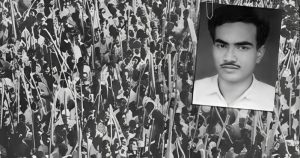 The police intercepted the procession from the middle to break it in front of the Medical College. There was a confrontation between students and police. The procession was divided, Asad Bhai was separated from me and he was shot point blank with a pistol by a police officer in front of the Medical College gate. Unfortunately, he succumbed to his injuries and became the first front line student leader and political activist to be “Shaheed” by police firing. His Sahadat played the pivotal role to convert the student movement into a student-mass movement. On 24 January, a school student Matiur was also killed by police firing and became a Shaheed. The student movement gradually took shape of a mass upsurge. The then Pakistan President Ayub Khan handed over his power to Military Janta Yahiya Khan.
The police intercepted the procession from the middle to break it in front of the Medical College. There was a confrontation between students and police. The procession was divided, Asad Bhai was separated from me and he was shot point blank with a pistol by a police officer in front of the Medical College gate. Unfortunately, he succumbed to his injuries and became the first front line student leader and political activist to be “Shaheed” by police firing. His Sahadat played the pivotal role to convert the student movement into a student-mass movement. On 24 January, a school student Matiur was also killed by police firing and became a Shaheed. The student movement gradually took shape of a mass upsurge. The then Pakistan President Ayub Khan handed over his power to Military Janta Yahiya Khan.
Maulanana Bhashani instructed Mannan Bhai for arranging a public meeting at Shibpur to pay homage to Shaheed Asad. He came to Shibpur in the evening prior to the meeting date. After the dinner, he discussed with us – the leaders and workers about the future of the movement. At some point he asked how far is the place where Asad has been buried, that it is about 2 Kilometres. He got up, put his chappal and said “chalo” – follow me. There was no light in the road, with the help of a torch light we went to the grave of Asad. He offered monajat and came back to Shibpur at about midnight. In his itinerary of Shibpur, the visit to Asad bhai’s grave was around 10 am next day, but Bhashani could not wait till morning, which shows how much he loved Asad Bhai.
The public meeting was a huge success. People from all walks of Shibpur area attended the meeting. Many of progressive leaders and workers from all over the country joined the meeting to show their respect for their beloved comrade Shaheed Asad. In his speech Maulana Bhashani paid tribute to Shaheed Asad and asked everybody to continue their struggle to fulfil the dream of Asad’s “Jano Gantatra” – People’s Democracy and to get rid of the Military Junta. Bhashani’s speech had a great inspirational impact on the students, youths and peasants of the area which played a significant role during the liberation movement. The peasants of the area took oath to work harder to fulfil the dream of their beloved leader Shaheed Asad.
In the year 1970, the Ekushe February Shaheed Dibos was celebrated with much enthusiasm all over East Pakistan. The EPSU (Menon) Mohsin Hall unit, published a souvenir named “Protirodh” on the occasion of the Shaheed Dibos; I edited the souvenir. We were first to publish the famous poem “Asader Shirt” of Shamsur Rehman in our Souvenir. It was a tedious job for getting the poem from the poet Mahfuzullah did a fantastic job and was able to get the poem. Asad Bhai and I were from the same village. I was able to procure his diary from his brother Rashiduzzan and published two pages of the diary as block print in the souvenir, which was highly appreciated by students, activists and intellectuals.
During the 11-point movement, Students Action Committee became the people’s action committee. In 1969, EPSU (Menon) was divided into two factions due to ideological differences – Biplobi Chatra Union and Bangla Chatra Union. I played a significant role in the formation of the Biplobi Chatra Union. My room 424 at Mohsin Hall was the centre of activities during the National Conference which was held at the then Iqbal Hall premises. Juno Bhai was elected the 1st President of the Biplobi Chantra Union, while Salu Bhai was elected General Secretary.
During that period, a coordination committee of the Communist Revolutionary of East Pakistan was formed for creating the atmosphere for revolution in East Pakistan. Kazi Zafar Ahmad, Haider Akbar Khan Rono, Rashed Khan Menon, Adbul Mannan Bhuiyan, Mustafa Jamal Haider, Haider Anowar Khan Jono were the leaders of the Coordination Committee. My room at the Mohsin Hall was the contact point.
With Haider Anowar Khan Juno, the valiant freedom fighter of Shibpur and his wife Mahbuba Rashid Chapal. The picture was taken in their residence few months before their death.
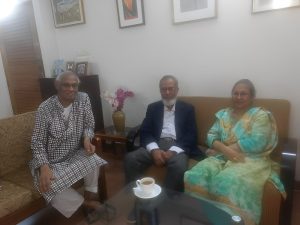 Jamal Bhai the President of EPSU, was under hulia (arrest warrant) in the Malek Murder case. He was hiding in my room for about 2 months to avoid the police arrest. We were actively involved in organizing the peasant movement, especially in the Shibpur area under the leadership of Abdul Mannan Bhuyia.
Jamal Bhai the President of EPSU, was under hulia (arrest warrant) in the Malek Murder case. He was hiding in my room for about 2 months to avoid the police arrest. We were actively involved in organizing the peasant movement, especially in the Shibpur area under the leadership of Abdul Mannan Bhuyia.
In mid-1970, I married Nazma Shikha an activist and leader of the EPSU (Menon). Nazma was one of the few EPSU activitists who managed to hide the dead body of Shaheed Asad on the roof-top of the Dhaka Medical College and carried his blood-soaked shirt in her vanity bag. This shirt was hoisted on a tall bamboo pole at the protest rally next day that led to the 1969 mass uprising. Even after our marriage we both remain active in politics.
After our marriage, Zafar Bhai had a meeting with us in a secret location as he was under hulia. He told us that the coordination committee had decided that I should join the labour movement in Tongi and my wife would be 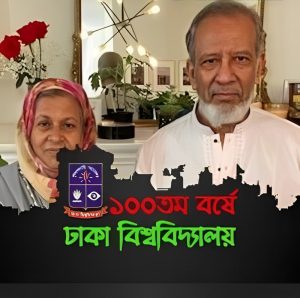 given a job in a school for the family income. The Party would also give some subsidy. I politely refused this offer and told him that I would not be a suitable person for the labour movement, rather I should contribute to the teaching and education movement. By this time, I joined as a Lecturer in Hazi Asmat College at Bhairab.
given a job in a school for the family income. The Party would also give some subsidy. I politely refused this offer and told him that I would not be a suitable person for the labour movement, rather I should contribute to the teaching and education movement. By this time, I joined as a Lecturer in Hazi Asmat College at Bhairab.
After a few months, I was selected by the Public Service Commission (PSC) and got my first assignment as a lecturer at the Government Jagannath College. I joined there and got registered for a Ph.D. programme at the Chemistry Department of Dhaka University, under the supervision of Professor S. N. Nabi.
During my resident student life at the Mohsin Hall, I used get in touch frequently with Mr Nurul Islam of Boteshwar (a DU officer); he used to treat me as his family member. His house became a hideout of the communist revolutionaries for the first 3 months of 1971. Jamal Bhai, Juno Bhai and others would come to this place for important discussions and planning for the liberation of Bangladesh (the then East Pakistan).
The mass participation of the people of Shibpur area in the liberation movement and struggle was praise worthy and unprecedented. In fact, the glorious participation of the peasants and students of Shibpur in progressive movements began to come to limelight from the beginning of the 1960s, when the progressive students of the country under the banner of East Pakistan Students Union were leading the movement against imperialism, colonization and expansionism.
Under the leadership and political guidance of Abdul Mannan Bhuiyan, Asad Bhai, myself and a vast majority of students and youths of Shibpur started working with the peasants because, our area was predominantly agricultural area. Maulana Bhashani was organizing the peasants of the country to get rid of economic and social oppression. In the mid-1960s, a huge peasant rally was held in Shibpur. Abdul Mannan Bhai was a key figure. This peasant rally played a significant role in motivating the peasants of Bangladesh under the banner of the Krishak Samity.
While motivating the peasants to be organized, we went as a group of student volunteers to the field when the peasants were at work. We discussed with them about the misrule of the government, the mistreatment of the local staffs in the Tahsil Office, Police station and corruption of Chairman and members of the union council and asked them to contact us in any need. Some of the peasants voluntarily donated paddy, jute or bamboo which were used for running a central office in Shibpur and few other local offices of the Krishak Samilty. We arranged sometimes cultural programmes or football matches under the banner of Krishak Samity, to popularize, the peasant organization.
Thus, before the end of 1970, the progressive force of Shibpur area was organized and motivated under the leadership of Abdul Mannan Bhuiyan. Mannan Bhai had a rare quality, he could mix with students, youths, peasants, seniors and elite of the locality. Abdur Rab Khan, Raihan Uddin Ahmad, Bashir Uddin Khan, Mozammel Huq, Moktar Khan and other seniors always patronized the political activities of Mannan Bhai. We the students, Asad Bhai, myself, Tofazzal Hossain, Mannan Khan, Awlad Hossain Khan, Shahid Bhuiyan, Jinhuk, Sento and others were always his followers as a vanguard.
This organized progressive force of Shibpur area made highly significant contributions the liberation movement and struggle of independence of Bangladesh. As we celebrate our 52nd Victory Day, I fondly remember many of my comrades and pray to the Almighty for the salvation of all those who laid down their lives for the liberation of this country. I also pray for those who have left this world.
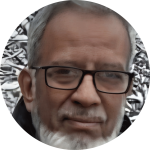
Jasim Uddin Ahmad
Professor Jasim Uddin Ahmad was Vice Chancellor of Jahangirnagar University, Bangladesh. He is former President of the Federation of Asian Chemical Societies (FACS) and the Bangladesh Chemical Society, obtained ‘Fellowship of FACS’. He was also President of the Federation of Bangladesh University Teachers Association and Jahangirnagar University Teachers Association, and Dean of Science faculty. He has 70 research papers; presented papers in many seminars; authored and edited 30 books; published about 200 popular articles. Profess Jasim Ahmad was awarded the Ekushey Padak in 2006 for his significant contribution in Education. Ever since his early student life he was active in progressive student and mass movement, participating in all major student movements since 1963. He was General Secretary of the Mohsin Hall EPSU (Menon). He was one of the organizers of liberation movement and struggle of independence. Professor Ahmad is the President, Bangladesh International Farakka Committee and one of the organizers of the 2005 Chilmari Long March and grand Rally where more than half a million people participated to protest against the unilateral upstream water withdrawal by India. E-mail: jasimahmad47@gmail.com
